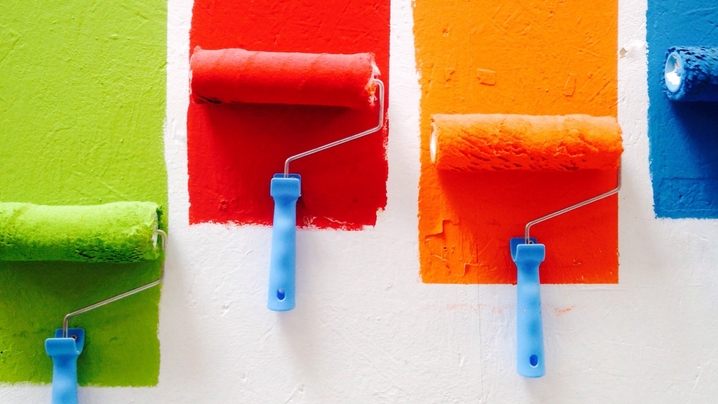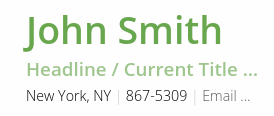
Using Color on Your Resume: 5 Design Tips to Get You Noticed

With these design tips and advice, you can use color to give hiring managers a great first impression of your professional work experience.
Recruiters and hiring managers receive dozens of resumes for any given position. Making your resume stand out in the haystack is essential, and color on a resume is a great way to do that. Color on a resume, when used correctly, can help you improve your resume, making it easier for you to land a face-to-face interview.
Browse our gallery of resume examples here.
The Best Colors to Use on a Resume
The resume colors you select will depend, in part, on your profession. The design of your resume should be a delicate balance between professional and creative. Too much color or the wrong color, and your resume could come across as unprofessional and end up in the trash.
An important element to consider when selecting resume colors and combinations is what best represents you. Yes, your personality should come through in the colors you select. With that said, you still want to be mindful of the colors you choose and use them with deliberation. The colors you select for your resume should also be the colors you use on your cover letter, website, the backdrop of your professional photos, and so on.
Browse our gallery of resume templates here.
Resume Color Attributes and Theory
Colors are known to represent different attributes that impact how they are perceived.
Some common colors and their attributes include:
- Red: Symbolizes power, passion, and action. Bright red can also evoke aggressiveness, so use deeper red hues, like burgundy or maroon.
- Blue: Symbolizes integrity, calmness, reliability, and trust.
- Yellow: Symbolizes positivity, good energy, happiness, and optimism.
- Orange: Symbolizes strength, productivity, and tenacity.
- Green: Symbolizes calmness, the environment, and development or growth.
- Purple: Symbolizes inspiration, royalty, and dignity.
Select deep, bold colors for crisp, clean resumes or soft, neutral colors for resumes that require a bit more elegance. If you’re an accountant or attorney, for example, you might select a deep burgundy-black-white color scheme, whereas if you’re an image consultant or baker, you might use a neutral peach-dark grey-white color scheme. Any single color goes well with black and white.

Professional and Creative Resume Colors
If you’re in a creative profession, such as copywriting, theatre, or voice coaching, then you are at liberty to have more fun with the colors you select. In fact, you want your creative nature to shine through. Though the recommendation for the majority of professions is to utilize deeper and softer hues, as a creative professional, you have some freedom to use brighter colors.

For professions that fall outside of the creative realm, deep or soft color schemes tend to work well. Burgundy with the traditional black and white, deep green, and deep blue can add enough pop for your resume. The purpose of color on a resume is to highlight and draw attention to specific details, not distract or overwhelm, so be tasteful in your selection.
Resume Writing & Formatting Tips That Integrate Color
Now that you have acquired some knowledge in how to select colors for your resume, it’s time to integrate them into your resume design.
Color works best when you use it to draw attention to specific areas of your resume, such as on the sidebar or across the top, and to highlight key points throughout your resume, such as notable accomplishments or bullet points.
Use Bright Colors as Accents
Bright, complementary colors can draw attention to certain high-priority details you want hiring managers or recruiters to see fairly quickly. Did you save thousands of dollars for the company? Did you increase sales by a significant number? Use bright resume colors to highlight these types of accomplishments.
Consider White Space
Whether you use color or not on your resume, it’s wise to allow for plenty of white space on your resume. Too many sections or large blocks of text can be overwhelming for the reader.

Emphasize Your Contact Information
Color on a resume is great to highlight your contact information. Contact information should be readily available and accessible to hiring managers, preferably in a prominent header format and color that contrasts or complements the dominant color scheme of your resume. You want hiring managers and recruiters to know how to contact you without having to look too hard.
Coordinate Your Resume's Color Scheme With Your Cover Letter
Your personal brand matters. In today’s world, it’s easier than ever for hiring managers and recruiters to research candidates. Create a consistent palette of colors and resume design elements across both resumes and cover letters, as well as any other job-related marketing tool you use. In doing so, those researching you can become familiar with your personal brand.
How VisualCV Supports Custom Color Schemes
VisualCV provides resume guides and templates that can be customized to suit your industry, your taste, and your personal brand.
The following VisualCV resume templates support color customization:
- Avant
- Clair
- Gallant
- Modern
- Monaco
- Monte
- Oak
- Vida
- Arya
- Vienna
- Chloe
Each template is unique, so you are free to experiment with resume colors to determine what works best for you and your job goals. Utilize these designs to have fun and create a resume that catches the eye of hiring managers and recruiters alike.
What is the best color to use on a resume?
A good rule of thumb to find the best color combination for your resume is to leverage colors that give out a good contrast between the font color of your resume and your resume background.
What is the most eye-catching color for a resume?
Any color that has a high contrast between the font color and the resume’s background will appear to be eye-catching to the hiring manager.
Is Green a good resume color?
Yes, green in general is a good color to use on your resume. However, you need to make sure that the green color has the right contrast with the font color to facilitate ease of reading.
- The Best Colors to Use on a Resume
- Resume Writing & Formatting Tips That Integrate Color
- Coordinate Your Resume's Color Scheme With Your Cover Letter
- How VisualCV Supports Custom Color Schemes
- What is the best color to use on a resume?
- What is the most eye-catching color for a resume?
- Is Green a good resume color?

Written By
Ben Temple
Community Success Manager & CV Writing Expert
Ben is a writer, customer success manager and CV writing expert with over 5 years of experience helping job-seekers create their best careers. He believes in the importance of a great resume summary and the power of coffee.

Figuring out how to design a resume isn't easy. Here are 10 great resume examples to inspire you.
April 9, 2015
Read Post

Co-Founder & Director

Don't make these common student resume mistakes when applying for a job.
March 19, 2015
Read Post

Co-Founder & Director

Read our free guide to the best action words to use on your resume.
November 23, 2021
Read Post

Co-Founder & Director
Copyright ©2025 Workstory Inc.